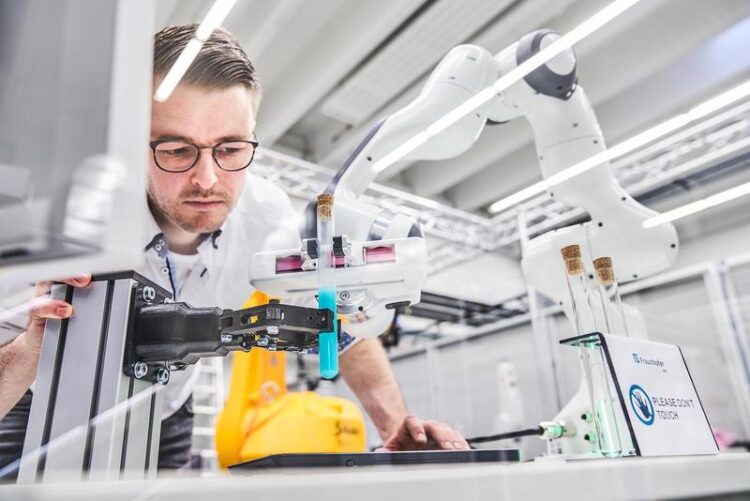Highly sensitive robot gripper: No need for pneumatics

Fraunhofer IEM is researching intelligent gripping systems.
© Fraunhofer IEM/Wolfgang Schroll
Force-sensitive, dynamic, energy efficient and with a range of applications – these qualities are what distinguish the new robot gripper created by the Fraunhofer Institute for Mechatronic Systems Design IEM. It can transport fragile objects from one production step to the next without damaging them. The gripper is specially designed for the food industry, where careful handling of fragile products helps to avoid waste. The electric drive makes costly pneumatics obsolete.
The robot gripper will be presented at the joint Fraunhofer booth at the Hannover Messe 2023 from April 17–21 (Hall 16, Booth A12).
Being able to transport, sort and pack fragile food automatically is no mean feat. The robot must handle the products quickly and dynamically, be it eggs, meringues, meatballs, cookies, pralines, donuts or anything else, without damaging them with pressure marks or other blemishes. As part of a project funded by the federal state of North Rhine-Westphalia, researchers at Fraunhofer IEM in Paderborn have developed a robot gripper, designed for use in the food industry. The system will be presented at the Hannover Messe 2023 at the joint Fraunhofer booth (Hall 16, Booth A12), where it will be displayed as part of a cobot workstation, moving chocolate-covered marshmallows without damaging their fragile coating.
The gripper system can be set up with two, three or four fingers and adapted for a range of tasks and purposes – meaning that it could also be used for the automated handling of other fragile products such as glassware. “The fingers have a plastic-based, soft and flexible coating, which enables them to keep a delicate grip on fragile materials and avoid damaging them. The robot gripper is also extremely dynamic and can easily be incorporated into production processes. It maintains the required balance between speed and sensitivity at all times,” says Dr. Christian Henke, head of the Scientific Automation department at Fraunhofer IEM. Precise and dynamic control technology enables targeted finger movement and complex product control. Sensors integrated into the fingers determine the amount of pressure required.
Saving resources with electric power
The special advantage of the system: the gripper is not operated pneumatically, but electrically. In this way, it works energy-efficiently and uses existing power connections. “Until now, gripper systems have been powered pneumatically, which uses a lot of energy. Generating pressurized air is less efficient – even less so due to frequent leakages in the lines,” explains the engineer.
Safety barriers not required for production
The system’s spatial radius of action can be expanded with a linear axis, i.e., a horizontal track. To do this, the robot gripper is mounted on a vertical lifting column, which is attached to the linear axis. The gripper is suitable for safe human-robot collaboration thanks to its sensor-based environment recognition system. This is not the case for the axes (both the linear axis and the lifting column), however. To render the entire workspace collaborative, the researchers have developed a 360-degree environment recognition system that monitors the full length and height of the axes and can be integrated into the base of the linear axis. “With this multi-sensor system, which includes distance and thermografic sensors, the entire cobot and axis structure can work collaboratively. This means that businesses don’t need to install safety barriers,” says Henke. “The gripper can either be combined with the linear axis and multi-sensor system or used on its own.” Initial tests have been successful, and the Fraunhofer IEM team is now looking for partners to manage bringing the robot gripper to market.
Weitere Informationen:
https://www.fraunhofer.de/en/press/research-news/2023/april-2023/highly-sensitiv…
Media Contact
All latest news from the category: Power and Electrical Engineering
This topic covers issues related to energy generation, conversion, transportation and consumption and how the industry is addressing the challenge of energy efficiency in general.
innovations-report provides in-depth and informative reports and articles on subjects ranging from wind energy, fuel cell technology, solar energy, geothermal energy, petroleum, gas, nuclear engineering, alternative energy and energy efficiency to fusion, hydrogen and superconductor technologies.
Newest articles

Silicon Carbide Innovation Alliance to drive industrial-scale semiconductor work
Known for its ability to withstand extreme environments and high voltages, silicon carbide (SiC) is a semiconducting material made up of silicon and carbon atoms arranged into crystals that is…

New SPECT/CT technique shows impressive biomarker identification
…offers increased access for prostate cancer patients. A novel SPECT/CT acquisition method can accurately detect radiopharmaceutical biodistribution in a convenient manner for prostate cancer patients, opening the door for more…

How 3D printers can give robots a soft touch
Soft skin coverings and touch sensors have emerged as a promising feature for robots that are both safer and more intuitive for human interaction, but they are expensive and difficult…





















